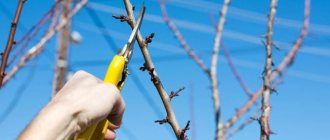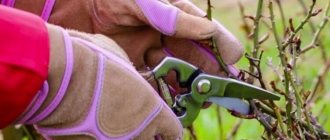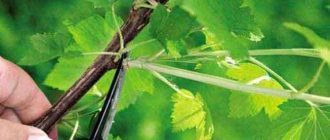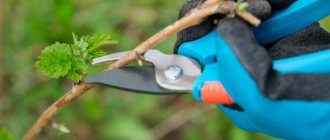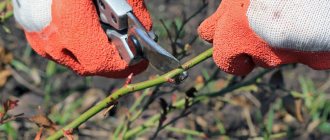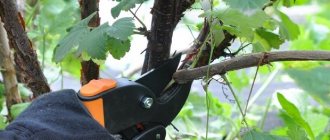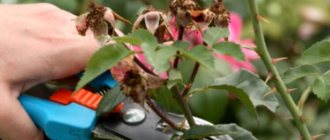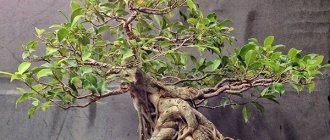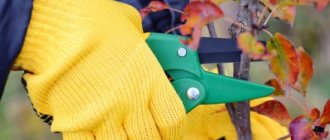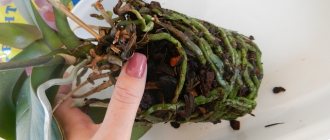In what cases is autumn pruning required?
Currant seedlings grow quickly - in a couple of years the bush grows, gains strength, and begins to bear fruit. After 3-4 years, fruiting begins to decline, and the bush itself loses its shape, becomes too bulky - it needs pruning.
It is best to prune currant bushes in the fall. When the bush has prepared for winter and the sap flow in it has stopped, the plant receives minimal stress from the removal of shoots.
Pruning is a complex agrotechnical activity, the intricacies of which gardeners have been studying for years. But the main rule is true for all types of pruning - each branch should receive its share of sunlight.
Pruning purposes:
- Remove old branches - they suck nutrients from the bush, reducing yield.
- Remove branches that thicken the bush to ensure sunlight reaches the fruits.
- Remove dry, diseased and frostbitten shoots.
Trimming results:
- the growth of young branches is stimulated;
- the growth and development of the bush accelerates;
- the bush takes on a neat shape;
- The fruiting period is extended to 15 years.
With proper care, you can extend the life cycle of a currant bush five times. We recommend reading the article on how to care for currant bushes in the autumn.
Trellis
The trellis-like shape of the currant bush looks very elegant. In addition to decorative functions, such planting greatly facilitates the process of fertilizing and collecting berries.
This form also opens the plant well to sunlight and insects that perform pollination functions.
The formation of a bush on a trellis goes through the following stages:
- selection of seedlings with 3 well-developed shoots;
- the central shoot will act as a support, 2 lateral shoots are placed opposite each other at a height of about 30 cm from the soil;
- the formation of subsequent tiers as the shoots grow and the removal of excess branches;
- After the final formation of the trellis, the central shoot is cut annually to the lower bud. The lateral processes are shortened by 2-3 cm.
Timing and weather conditions
Autumn is the most favorable and safest time for pruning bushes. It is dangerous to prune currants in the spring - they begin to bud early, and the threat of frost in the spring is great. In autumn there is no such danger - you can slowly remove all the extra shoots.
The procedure is carried out at the end of October or at the beginning of November, when all vegetation processes in the bushes end. In cold weather there is less stress and injury to the plant. Pruning is carried out when the bushes have shed all their leaves. It is convenient for a gardener to assess the condition of branches on bare bushes. Pruning is done on a dry, fine day.
By region
When pruning currants, you need to fit in the interval between the fall of the leaves and the onset of the first frost. The exact timing of pruning depends on the region and its climatic conditions.
Timing for pruning currants by region:
| Region | Recommended timing |
| Moscow region | end of October (soil freezing here begins around November 15) |
| Leningrad region. | from October 15 |
| Siberia | Given the unstable climate of the region, pruning is carried out here from the beginning of September |
To make sure it is time to prune, cut the shoot. If sap flows from the wound, it is too early to prune the bushes; postpone the procedure for a week.
According to the lunar calendar
Experts do not recognize the Lunar calendar, but amateur gardeners often look at it. It is believed that the best time for pruning trees and shrubs is the waning moon (phases 3 and 4), when plant juices tend to fall. In autumn, pruning is recommended to be done on the debilitated moon, shortly before the new moon.
It is strictly not recommended to prune currants during a young moon, especially a few days before the new moon. But experts say it is best to trim the tops during the new moon.
The best days for autumn pruning according to the Lunar calendar for 2019:
| Month | Favorable |
| September | 2, 5, 7, 9 |
| October | 1, 4, 5, 10, 29, 31 |
| november | 3, 7, 8, 11, 28, 30 |
Gardeners believe that pruning on a waxing moon makes the bush thick and spreading, and on a waning moon it helps to build up the root system.
What care do pruned bushes need before winter?
After pruning, the soil under the currants is dug up with the addition of potassium-phosphorus fertilizers and completely decomposed compost. For an adult bush you will need:
- 30–40 g superphosphate,
- 15–20 g potassium salt,
- 1 bucket of compost.
For young plants, 2–3 times less fertilizer is applied depending on their size.
Where there are severe frosts without snow, the soil under the bushes of the first or second year can be mulched with sawdust or spruce branches in a layer of 5–10 cm. Adult currants are more hardy.
In regions with heavy snowfalls that break branches, tying currant bushes for the winter is practiced. You need to take a strong synthetic rope, wrap it around the bush, lightly pull all the branches towards the center and tie a secure knot. In spring, untie before buds begin to bloom.
Tools and other equipment
Pruning tools should be sharpened and disinfected - this will allow you to make neat cuts without spreading the infection to healthy bushes.
To prune a currant bush, you will need:
- Garden knife. With its help it is possible to make even cuts. Use only on thin branches.
- Secateurs. For removing thin and medium-aged shoots.
- Hacksaw. Take a saw with small teeth - for cutting thick branches.
- Brush cutter. Will cope with branches of any thickness. Allows you to give the bush the desired shape.
- Lopper. A tool with long handles that allows you to reach branches in hard-to-reach places.
Pruning goals
There are several types of currant pruning. Each type of pruning is carried out for a specific purpose:
- Sanitary. Its goal is to remove all unnecessary shoots, diseased, damaged, dry, defective. It is forbidden to break out the shoots with your hands, leaving stumps - the risk of rotting the bushes increases.
- Rejuvenating. Aimed at removing old branches that draw plant juices onto themselves. As a result, the yield of the bush increases.
- Molding. This pruning is aimed at forming a certain concept of the bush. Achieve uniform fruiting of branches of different ages. The bush is given a neat and attractive appearance, easy to maintain, and conducive to the ripening of berries.
- Supportive. It is carried out throughout the life of the bush and is aimed at maintaining good growth, fruiting and health of adult plants. The goal is to prevent branches from growing beyond the boundaries of the formed bush.
- Topping. It involves removing the tops - 2-5 cm of shoots are cut off with pruning shears. The process is similar to mold trimming, but the effect is similar to the sanitary and rejuvenating procedure. Pinching is used only on black currants, since in red and white, the berries are formed precisely on the upper branches, and removing the tops will negatively affect their harvest.
Video: mulching red currants in autumn
All this is done in order to enjoy their own berries at the end of the season. Although the season ends not with harvesting, but with preparing the site for winter. And then there is spring and new troubles.
For the pleasure of eating delicious jelly or fresh juicy red currant berries, you have to plant bushes, water them, care for them, and prune them. But this work brings joy to gardeners and brings fruit.
- Author: Armenuhi Poghosyan
Hello! There are so many different topics in the world! I hope that by collaborating with this site I can share my thoughts and knowledge with others. Rate this article:
- 5
- 4
- 3
- 2
- 1
(36 votes, average: 4 out of 5)
Share with your friends!
Pruning rules
The procedure and rules for pruning currants in the fall:
- First, sanitary pruning is carried out, removing:
- cut into a ring, broken, thin, short shoots growing deep;
- one of two intertwined shoots;
- branches lying on the ground - in summer they lack light and practically do not bear fruit;
- branches affected by diseases and pests.
- branches whose wood has not matured - they will be damaged during frosts.
- Then anti-aging pruning is carried out:
- remove all shoots older than 5 years;
- branches older than 3 years are shortened by a quarter;
- when pruning annual shoots, leave 4-5 of the strongest shoots, cut out the rest;
- cut back the annual growth by a third.
- Next, molding pruning is carried out, the subtleties of which depend on the type of bushes - red and black currants are pruned differently. Remove all excess shoots that have grown over the summer.
The video below presents the rules for pruning currants in the fall:
To increase productivity, several branches of different ages are left on the bushes - from 1 to 6 years.
Rules
Every gardener must adhere to simple rules for sanitary processing of berry crops:
- You cannot begin rejuvenating and pre-planting pruning until the leaves have completely fallen off.
- Be sure to make even cuts. Otherwise, the plant will be sick for a long time and will die in frost.
- Do not leave cuttings of old, diseased branches in the garden. Throw them in a landfill or burn them.
- If you remove bushes at the root, leave a small stump (no more than 5 cm in height) in the garden bed. Otherwise it will become a home for pests.
- After pruning, treat the “wounds” on the bush with brilliant green or garden varnish. Copper sulfate and hydrogen peroxide can be used as an antiseptic.
Ignoring the safety rules of agricultural procedures in the garden will increase the risk of currant death or infection.
Pruning methods and instructions for them
Currant pruning must be carried out throughout the life of the bush. There are different methods of pruning - they differ not only in the technique of execution, but also in the tasks assigned. Let's look at the most popular pruning methods.
Before boarding
Principles of pruning seedlings before planting:
- Before planting seedlings in the ground, their tops are cut off.
- Only 2-3 buds are left on each branch.
- Weak branches are pruned more strongly - only 1-2 buds are left.
Trimming the tops stimulates branching, which promotes yield growth and makes the bushes more powerful.
For rejuvenation
Anti-aging pruning is best done in the fall. The timing depends on the type of currant:
- black is rejuvenated at 5 years of age;
- red - at 8 years old.
To rejuvenate currants, remove old shoots in one of three ways:
- Cut into a ring. The entire branch is cut off - no stump is left. The cuts must be covered with garden varnish.
- Cut to the bud. The shoot is shortened - only part of it is cut off. If the bush is sparse, make a cut on a bud that looks deep into the bush - so that it becomes denser.
- Cut to the outer bud. If the bush is too thick, then the cut is made on the outer bud - so that it becomes thinner.
Anti-aging pruning has its own nuances for red and black currants:
- The main crop of blackcurrant ripens on three-year-old shoots. Therefore, all branches older than 5 years are deleted. To stimulate the growth of annuals, they are cut by a third. If there are many two-year-olds on the bush - more than 8 - then the three-year-olds are cut out completely.
- Red and white currants have the most productive shoots - 5-8 years old. Therefore, all branches older than 8 years are removed, leaving no more than 12 branches on the bush.
Also, partial rejuvenation is often carried out on red and white currants - pruning with transfer to branching. In this way, old but fruit-bearing branches, 5-6 years old, are rejuvenated. Choose a strong branch of the 1st order. The skeletal branch is cut off after branching.
Old overgrown shrubs are gradually rejuvenated, leaving 15-18 fruit-bearing branches. Rejuvenation procedure:
- Trim off zero shoots, leaving the three strongest ones.
- Remove all shoots that thicken the bush.
- Gradually cut off old skeletal branches - 5 pieces per year, no more. First, remove those that are more than 5 years old - they are easy to recognize by their small growth, bark color and second-order branches.
In 3-4 years the old bush is restored to normal condition.
An experienced gardener explains what you need to know about pruning currants in the video below:
After harvest
Experienced gardeners practice pruning immediately after harvest. The advantages of this pruning:
- The branches receive more sunlight, which promotes photosynthesis of young shoots.
- The plant does not waste energy on shoots it does not need.
- The internal branches, as well as the lateral shoots, grow intensively - a beautiful bush shape is formed.
- The risk of fungal infections is reduced.
Pruning immediately after fruiting increases the yield of the next year. If you notice that the fruiting of the bush is declining, collect the berries and cut out 2-3 skeletal branches - at the root. The main thing is not to leave any stumps. This way you will make room for new branches, the sun will better illuminate the fruits next year.
Michurinsky method
A personal garden is one thing, an entire plantation of shrubs is another. For industrial scale, conventional pruning techniques are unprofitable. For intensive cultivation of currants, the Michurinsky method of pruning is used. This method was developed at the All-Russian Research Institute of Horticulture named after. Michurin, it increases productivity by 30%.
The order of cutting currants according to Michurin:
- Planted currants are not pruned for 5 years. Fruiting begins in the second year.
- In the 5th-6th year, 50% of the plantation is cut out at the root. The soil is fertilized. The remaining bushes continue to bear fruit.
- A year later, the regrown root young growth is thinned out, leaving about 20% of the shoots.
- After another year, the remaining part of the old bushes is cut out. The rest are thinned out and pruned.
The rejuvenation allows harvesting for another three years. Then the bushes must be uprooted.
Radical method
Radical pruning is carried out during the rejuvenation of bushes aged 8-15 years. Its goal is to prolong fruiting.
The procedure for radical pruning:
- Trim all branches to the base. Leave stumps no more than 3-4 cm high.
- Lubricate the cut areas with garden varnish.
- Sprinkle the soil near the stumps generously with humus and sprinkle it over the stumps remaining from the bush.
- To prevent the roots from freezing in winter, the remains of the bush are mulched on top with straw or sawdust.
The time of the event is late autumn, when all the leaves fall from the bush. Radical pruning helps to awaken the root buds, and new shoots will appear in the spring. The strongest ones will be selected from them and a new crown will be formed from them.
Trimming on a trellis
The method of growing berry crops on trellises came from Western Europe. This approach reduces the final yield, but the berries are sweeter and larger.
The procedure for pruning currants when growing on trellises:
- After planting the seedlings, cut off all side shoots - up to 5 cm. Such large pruning turns the growth buds into fruit buds.
- Trim branches located near the ground so that the berries do not touch the ground. Do not touch the main shoot. With systematic pruning of the lower branches, the crop is formed at a height of 90-150 cm - this simplifies harvesting.
- If the plant develops two trunks, then choose the stronger one, and remove the second one.
- In subsequent years, shaping is carried out, regularly cutting out root shoots and those located close to the ground. In appearance, the currant bush should resemble a columnar tree.
Pruning currants on a trunk
Once upon a time, standard pruning was popular in Russia - back in the 19th century, then it was forgotten, and now it is becoming popular again. This unusual pruning method allows you to form a spreading mini-tree from a currant bush.
Trimming order:
- Choose one shoot, the most powerful one - it will become the trunk of the currant “tree”. Trim all other branches.
- Shorten the vertical shoot selected for the role of the trunk to the desired height - 80-100 cm. Leave 3-4 upper buds to form the crown.
- Wrap the lower part of the shoot with an opaque film or put on a tube (plastic, rubber). Place a support—a pipe, a piece of wood, or something similar—to support the “tree.”
- Pinch out the side shoots that will appear at the upper buds after 3-5 leaves.
- In the second year, pinch out new cuttings.
- In the third year, the plant takes the form of a tree. Cut out all broken, diseased and weak branches. Remove the growth constantly.
Which red currant branches need to be pruned?
Before we start pruning, let's figure out which branches the bush needs and which ones interfere with growth and fruiting. The lightest shoots extending from the roots are zero, otherwise they are called renewal shoots or first-order shoots. In the first year they are straight and do not branch. By the second year of life, lateral branches appear on them - shoots of the second year, etc. The shoots grow especially rapidly in the first three years, then their growth slows down and fruiting decreases. To constantly stimulate the growth of new shoots, shoots of the second and subsequent orders are pruned.
Before you start pruning the red currant bush, determine which shoots need to be removed
However, you should not get too carried away with pruning, otherwise top shoots may form - vertically located branches that appear on the perennial wood of old skeletal branches. They are characterized by intensive growth and weak branching. If there are not enough zero shoots to rejuvenate the bush, you can cut off the old branches not completely, but only to the top shoot, which is then shortened to a suitable outer bud to stimulate branching.
Berries do not grow on top shoots, and the bush takes a lot of effort to develop them
Fruit buds on red currants are formed mainly at the tip of the shoots. Therefore, when pruning, there is no need to shorten all branches: fewer fruit buds are formed on older branches, so shoots older than 4–5 years are cut out.
When pruning red currants, remove the upper parts of the shoots to preserve the fruit buds
Pruning by year
Currant pruning is carried out annually. The seedling is pruned for the first time immediately after planting - even before the first winter in its life. During the first pruning, all foliage and young shoots are removed - only the buds in the lower part of the seedling are left. In the future, from year to year, the pruning procedure changes slightly.
One year after landing
In the second year of life, currant seedlings are shortened and pinched - this is the main purpose of pruning at this stage. Thanks to this pruning, the correct shape of the bush is formed and the development of the plant is accelerated.
Features of pruning a year after planting:
- Leave only the most powerful shoots. The optimal quantity is 3-4 pieces. All other growth is cut off.
- It is recommended to pinch off the tops of the remaining shoots.
Before pruning a seedling, assess its condition - in weak bushes the growth is cut by 2-3 buds, in a moderately developed plant only 1-2 shoots are left.
After 2 years
In the third year of life they continue to form a bush. The cutting order is as follows:
- Do not trim last year’s branches, or shorten them by a couple of buds so that the crown is formed evenly.
- Cut out all root growth.
- Remove all young shoots growing towards the trunk, as well as all adjacent branches.
- Of the young ones, leave 2-3 of the most promising ones.
3 years later
In the fourth year of life, the formation of the bush is still ongoing, so pruning almost repeats the previous one:
- Cut out the root shoots completely so that the bush does not grow and thicken.
- Remove weak young branches growing inside the bush. Leave only those that grow from the trunk.
- Leave branches from last year and earlier. Shorten their ends to avoid wasting nutrients.
If pruning is done correctly, then in the 4th year of life the currant is a developed bush of a spherical shape. The approximate number of shoots at this age is 10, all of them of different ages.
In this video, the gardener shares his experience of pruning fruit and berry bushes using the example of red and black currants:
Further trimming
In the fifth year of life, the currant bush reaches its peak fruiting. At the same time, lignification of shoots begins, the life cycle of which is coming to an end. If you do not remove them, the yield will begin to decline - older shoots will take away the strength from the bush.
Principles of pruning in the 5th year of life:
- The main goal at this stage is to rejuvenate the bush, so remove all old and dried branches to make room for young shoots.
- Do not cut off all old woody shoots at once - you should not expose the bush to such stress. These branches are pruned gradually, from year to year.
- When pruning old branches, at the same time remove diseased and crooked shoots, as well as tops - these are vertically growing fattening shoots that take away the strength of the bush. Leave only healthy, fruit-bearing branches.
- Cut branches 2-4 years old to the 4th bud, and annual branches to the 2nd.
Rake and burn fallen leaves and any trimmed branches to prevent the spread of pests and diseases. Read about currant diseases and pests here.
Do I need to prune red currants?
Overgrown currant bushes can be found in abandoned areas. And if in early spring they delight with clusters of elegant flowers, in summer there are only rare small berries on the branches, and the bushes themselves most often look sick and pitiful. Currant plantings need care, as they love lighting and fertilizing, as well as access to air, so that pests and diseases do not develop in shaded and dense thickets. Pruning regulates growth and shapes the crown, and also heals and rejuvenates the bushes. Indeed, with a decrease in the total number of shoots, the plant gives up its strength in a targeted manner, while the cluster develops in favorable conditions, and berries are formed that are exceptional in taste and size.
Well-groomed red currant bushes produce an excellent harvest
Features of pruning currants of different varieties
The pruning technique, or rather its subtleties, depends on the type of currant. Nuances differ between currant varieties:
- Altai;
- with active shoot formation;
- with passive shoot formation.
Altai varieties
A distinctive feature of Altai varieties is fruiting in the middle and upper parts of the stem. Therefore, if you cut off these parts of the shoots, the yield is reduced. In these varieties, only old, well-bearing branches are pruned. All other shoots are not shortened, except for diseased and insect-damaged shoots.
With active shoot formation
Varieties with active fruiting have a large number of zero shoots - they are formed in large quantities every year. They germinate mainly in the root zone of the bush. These shoots have few branches and must be cut. If the young shoot has grown to 30 cm, it is pruned, cutting off weak buds.
With passive shoot formation
Varieties with passive fruiting are in less demand than previous types of currant varieties - they grow too slowly. Young branches on such bushes are cut off slightly, or not at all. By cutting off tops and old branches - 6 years of age, they give the young growth the opportunity to feed and produce a good harvest.
How to increase the yield of currants
Before planting the bushes, it is necessary to carry out special treatment; the shoots are shortened so that the number of buds on each is no more than 4. This harsh method of pruning gooseberries will allow you to get a good harvest in the future. The main task of a gardener is to trim off dead branches. They need to be shortened to the place where new, young branches have formed.
It is very important to prune old “dead” shoots, because they consume nutritional energy and do not produce fruit, this will negatively affect fruit-bearing branches. After planting, gardeners take care of the gooseberry bushes for quite a long time without any return, the leaves grow poorly, and it does not produce fruit. This condition can last about 2-3 years, followed by the flowering of this bush. The main peak of productivity occurs at approximately 5-10 years of life, then the fruiting ability will gradually subside.
Forming gooseberry bushes in the fall has its advantages. The period for removing shoots in the spring is quite short, so experienced gardeners prefer to do this in the fall. It is necessary to harvest the crop, only then prune the shoots, so damaged and dead branches will be better visible. After winter, the bush has to be formed; many people use all kinds of garters and supports for this.
When the moment of formation of the bush comes, it is necessary to leave 3-4 zero shoots. This is done with a long-term perspective, in order to get about 30 healthy branches in the next 5-6 years, while their age will vary. After planting, the plant will take root and develop its root system, so at first you don’t have to think about getting a harvest. Don't forget to cut off any branches that are trying to grow inside the bush.
Basic care rules:
- Do not prune in summer, as this will cause the shoots to be fragile and may not survive the winter cold. This fact has been confirmed by many experienced gardeners;
- try not to cut off the entire bush; at least 30% of all branches should remain on it, otherwise the plant may simply die. Also pay attention to the age of the gooseberry; a mature bush at the age of 20-30 years will never produce much harvest, unlike a 5-10 year old one;
- do not remove growths from fruiting shoots;
- regularly inspect the bark of the branches, so you can monitor their age and health;
- trim dead shoots that have turned black;
- remove branches that have grown too far from the bush or are at a fairly low level;
- follow a simple rule: leave a small distance between gooseberry bushes so that neighboring plants do not interfere with each other, consuming other people's sun rays.
As written earlier, rejuvenation of an old bush should occur gradually. Ideally, no more than 50% of all branches can be removed in one year, but experienced gardeners prune old plants gradually.
Judging by the bark, you can understand which branches are the oldest, and remove them in the fall. Likewise, it is not difficult to maintain the fruiting capacity of a gooseberry bush for several decades. With equal care, an aged and a young plant will produce different amounts of fruit, so decide for yourself whether to plant a new one or rejuvenate the old one. Thanks to these simple rules, you can get a good harvest from your gooseberry bush if you follow them every year.
The amount of harvest depends not on the number of branches, but on the number of fruit buds. Sometimes it happens that a branch gives good growth, but there are few buds on it. Then the part of the shoot where there are fewer buds is shortened so that there is no bare part.
How do they do it correctly? The cut is made 5 mm above the bud at an angle of 45º. If you cut it higher, the shoot will dry out or the wound will take a long time to heal. It is better to make the cut on the outside so that the bush does not thicken.
If you want to rejuvenate an old bush and put it in order, pruning is done in several stages. First, in the fall, they cut out all the old branches, and in the spring they look at how many branches to leave and do the pruning a second time.
The number of branches left (young and old) should be no more than 15. When all unnecessary branches are cut off, the bush will remain unthickened. Most importantly, the middle of the bush will open and each branch will be illuminated by the sun, receive more nutrients and, accordingly, the berry harvest for next year will be good.
Gardener mistakes
Common mistakes when pruning currants:
- They leave a lot of branches. Beginner gardeners often feel sorry for the shoots - they don’t cut them, they leave too many old branches. Such pity results in a drop in productivity. The bush spends energy on maintaining old branches, and not on forming a crop.
- The timing of pruning is chosen incorrectly. If you are late with pruning, the bush may freeze. If you start pruning when the leaves have not yet fallen and the sap flow has not stopped, the currants “cry” for a long time after pruning. The plant becomes stressed, the risk of infection increases, immunity and productivity decrease.
Autumn pruning is a mandatory agrotechnical measure when growing currants. By remembering the order and rules of pruning, you can maintain the yield of bushes at a high level and extend their life cycle.
0
0
Copy link
